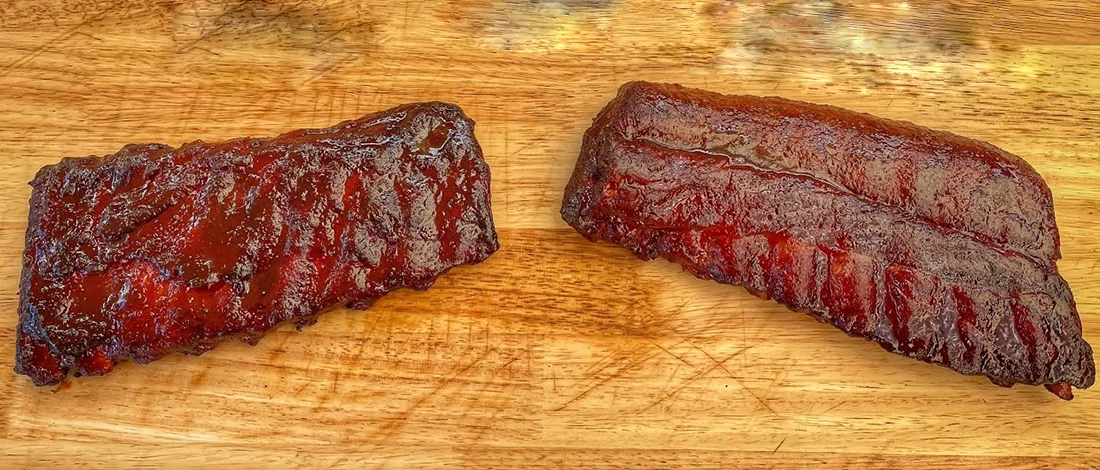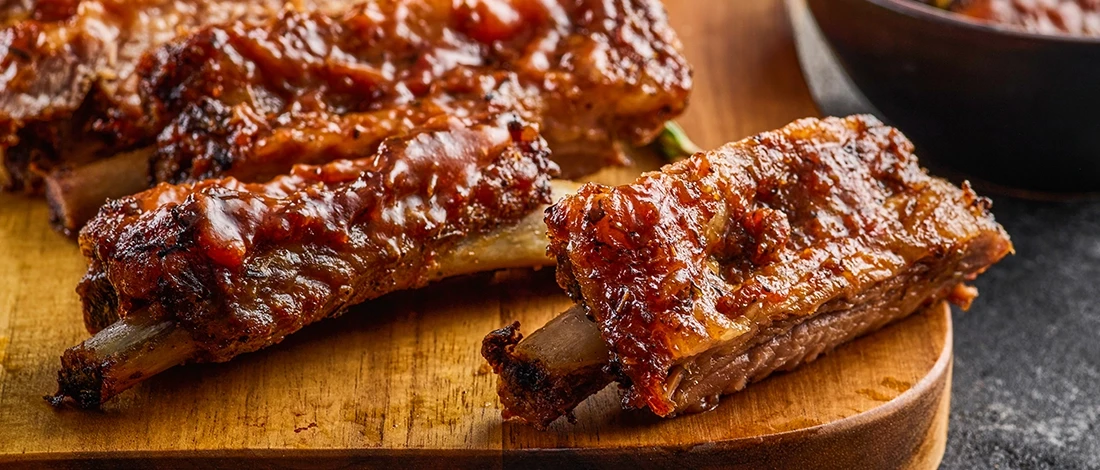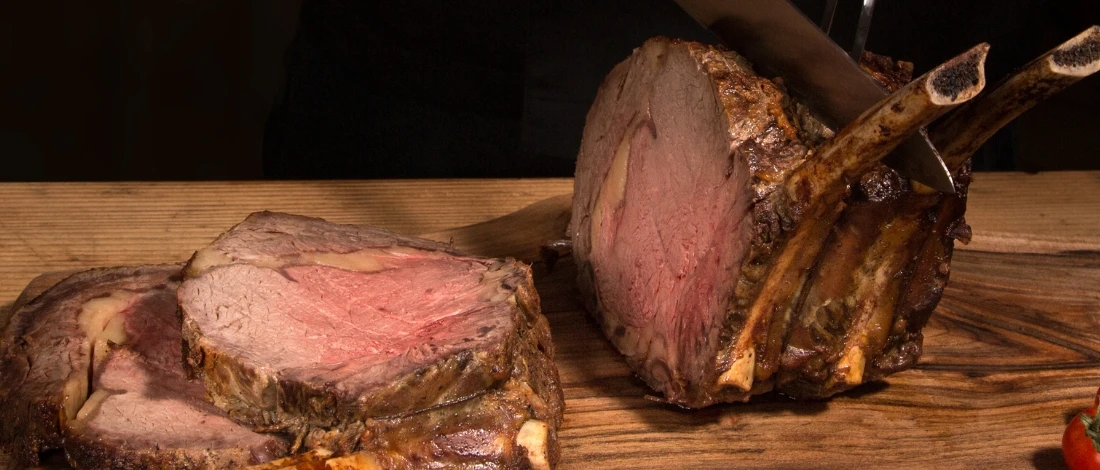No backyard cookout or BBQ restaurant menu is complete without ribs – baby back ribs, to be more specific!
Everyone knows they’re sweet, sticky, meaty, and tender, but what are baby back ribs exactly? Are they pork or beef? And isn’t every rib the same?
Our Carnivore Style's team of BBQ pros share all the juicy facts about baby back ribs, what makes them a firm family favorite, handy cooking tips, and how they differ from other cuts of meat.
Baby back ribs (loin ribs, back ribs, or riblets) are from the upper rib racks of pigs. These ribs differ from spare ribs, which are cut from the lower ribcage. A single baby back rack has an average of 10 to 13 short, lean, and tender ribs. These ribs can be baked, grilled, or smoked.
Quick Summary
- Baby back ribs are a tender and lean cut of pork from the upper ribs of the pig.
- Baby back ribs can be baked, grilled, or smoked slowly, and taste great with sauce or a rub.
- A 2013 collaborative study conducted by the USDA, Texas Tech University, and the National Pork Board analyzed nutrient changes in three fresh pork cuts between 1992 and 2010, including baby back ribs, and found increases in moisture and decreases in total fat and cholesterol, alongside variable mineral content [1].
- They are named baby back because they are shorter than spare ribs.
Baby Back Ribs Fast Facts

Baby back ribs are a cut of pork that comes from the upper ribcage area of a domestic pig. They are also known as loin ribs, back ribs, or riblets.
These particular ribs are cut from the part of the ribcage attached to the backbone, below the loin muscle [2].
Baby back ribs are short and curvy, and they contain a substantial amount of lean meat on top and between the bones.
These ribs do not come from piglets- they are called babies because they are shorter when compared to the other cuts of pork ribs.
Delicious, lean, and tender, baby back ribs are adored throughout the world, particularly in the Americas, UK, and parts of Asia.
You can also cook this cut using any of these types of BBQ smokers.
‘’In fact, many people will tell you that baby backs are the best rib pork meat you can get. We don't disagree.’’
- The Bearded Butchers [3]
How Many Baby Back Ribs Are In A Full Rack?
A single rack of baby back ribs generally contains an average of 10 to 13 curved, finger-like ribs.
Each rack weighs between 1 ½ to 2 pounds (680 to 900g), of which half the weight is bone. According to an article on the Kitchn, a single rib is around 3 to 6 inches (8 to 15cm) long [4].
BBQ chefs across the board confirm that a rack of baby back ribs can usually feed 1 to 2 people if they are the central part of the meal. (BBQ fanatics may tend to disagree, as there is always room for more baby back ribs!).
The Flavor Profile Of Baby Back Ribs

Baby back ribs are the epitome of finger-lickin’ good food! As it is a cut of pork, the ribs have a distinct, bacon-like flavor with a rich, meaty texture.
This particular cut of the rib has lean and tender meat.
Since they don’t have much taste on their own, baby back ribs take on the flavor of any marinade or spices they are prepared with.
The meat’s moderate fat content enables the ribs to absorb all the delicious flavors.
Originally from the US, BBQ-style ribs are a staple of American cuisine.
The ribs are immersed in a sweet, sticky, and slightly tangy barbeque sauce before they are cooked in the oven, smoker, or on the grill.
They will have an irresistible smoky flavor when cooked over an open flame or in the smoker.
Asian-style baby back ribs are also a hit, and they are covered in a salty but sweet garlic and sesame sauce or a sweet-and-sour glaze.
The Difference Between Baby Back Ribs And Spare Ribs

Two different cuts from the same ribcage:
Baby Back Ribs
Baby back ribs are cut from the upper ribcage, where they are connected to the backbone (hence the name, baby back) and they wrap around the loin.
They tend to be smaller and more curved. These ribs have more tender, leaner meat in comparison to spare ribs.
Baby back ribs are meatier, and take less time to cook due to their small size and lower fat content. There is a high demand for this tender and lean option, which typically translates to a higher price tag.
Spare Ribs
Spare ribs are the bottom half of the ribcage, cut from the underside (belly) of the pig, and they run along the breastbone.
Spare ribs have a bit more fat on them since they come from the belly. They're a little tougher as well since the muscles around the rib cage expand and contract a lot.
Spare ribs are straighter, longer, and broader than baby back ribs (flat and triangular), and a full rack usually consists of 11 to 13 ribs.
These ribs have more marbling (fat between the meat) which makes them juicier and extra flavorful. They will require a longer cooking time due to the cartilage and fat content.
St. Louis ribs are simply spare ribs that have been trimmed to create a more uniform, rectangular rack of ribs that’s easier to cook and slice at home. The cartilage, sternum, brisket bones, and rib tips are usually removed.
Also Read: Baby Back Ribs vs St Louis
Can You Get Beef Baby Back Ribs?
Pork ribs are known exclusively as baby back ribs. The same cut of meat from a cow is known as beef back ribs.
They are also a cut from the upper ribcage that grows close to the spine.
The Best Way To Cook Baby Back Ribs
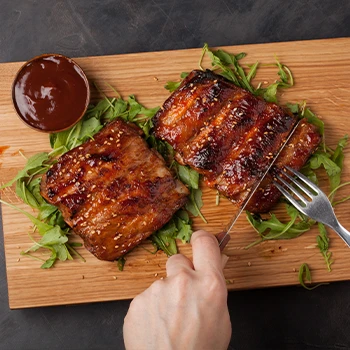
Baby back ribs are incredibly versatile and a dream to cook since they don’t take as long as other rib cuts.
They can be grilled, baked, or smoked, and generous seasoning is the key to incredible flavor. No matter what your cooking style, low and slow is the way to go!
According to the USDA, ribs are cooked when they reach 145 degrees [5].
Create a rub by combining light brown sugar with various spices such as paprika, cumin, garlic powder, onion powder, salt, and black pepper.
It’s all about that thick, sticky, and sweet basting! Classic BBQ sauce is generally a mix of brown sugar, ketchup, Worcestershire sauce, apple cider vinegar, liquid smoke, crushed garlic, paprika, onion powder, salt, and black pepper.
Give your baby backs some Asian flare with a sweet and sour sauce. Marinate the ribs in a mix of rice vinegar, canned pineapple juice, brown sugar, ketchup, soy sauce, canola oil, ginger, and spices.
Oven-Baked Baby Back Ribs
Oven baking at 250˚F (120˚C) is highly recommended for baby back ribs, as this method gives you a tender, moist, and tasty result. It is also the most straightforward way to prepare ribs.
According to celebrity chef and grill master, Bobby Flay, it’s all about the barbeque sauce! ‘’.. you need a lot of barbecue sauce. And when I say barbecue sauce, I mean the real classic red base. Barbecue sauce. A little spicy, a little sweet. Lots of flavor. ‘’
- Bobby Flay, How To Make The Perfect Ribs In The Oven [6]
You can finish off by grilling the ribs to produce a delicious, charred crust.
Smoked Baby Back Ribs

Smoked baby back ribs are a definite crowd pleaser! For fantastic flavor, rub the ribs in the spice mix 1-2 days before smoking. Professional chefs suggest the ‘2-2-1 schedule’ [7].
- Smoke the ribs at 225˚F (107˚C) on the grates for 2 hours.
- Remove the ribs from the grill, baste with barbeque sauce and wrap tightly in foil before returning to the grill for a further 2 hours.
- Carefully unwrap the foil, return the ribs directly onto the grill, and baste generously with sauce every 10 to 15 minutes while they cook for the final hour.
How To Tell When Baby Back Ribs Are Ready
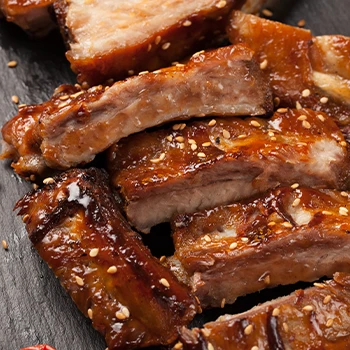
Like most meats, allow the rack of ribs to rest for about 10 minutes before you carve and serve. You can make a small slit into the meat to check if it is ready.
The first layer near the surface might be slightly pink, which is normal (especially if it has been smoked). The center should be white, with no pink juices.
Another popular method is to check for ‘pull back’, when the meat contracts and exposes about an inch (2,5cm) of the bone at the ends of the ribs.
At Carnivore Style, we want to help you enjoy every bite of your BBQ with simple, delicious tips. Check out our other guides for more expert advice on grilling and cooking the best cuts of meat.
References:
- https://www.sciencedirect.com/science/article/pii/S2211601X13000163?via%3Dihub
- https://www.bonappetit.com/story/how-to-buy-pork-ribs
- https://beardedbutchers.com/blogs/news/spare-ribs-vs-baby-back-ribs
- https://www.thekitchn.com/whats-the-difference-between-baby-back-ribs-and-st-louis-ribs-meat-basics-219386
- https://www.fsis.usda.gov/food-safety/safe-food-handling-and-preparation/meat-fish/fresh-pork-farm-table
- https://www.foodandwine.com/video/bobby-flay-how-make-perfect-ribs
- https://www.smoking-meat.com/july-12-2012-221-baby-back-ribs-on-big-green-egg-ceramic-cooker


